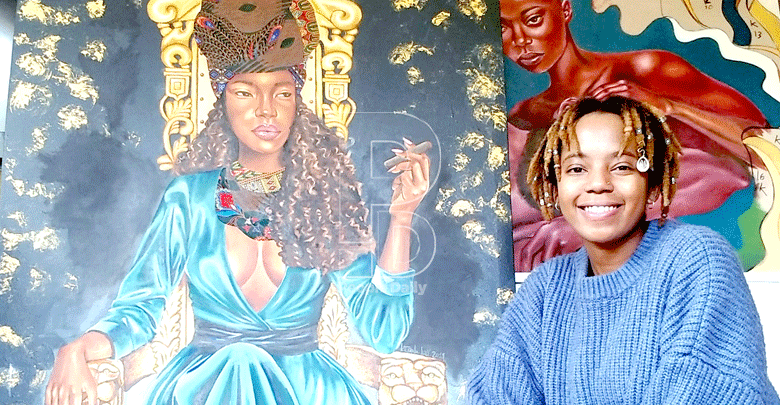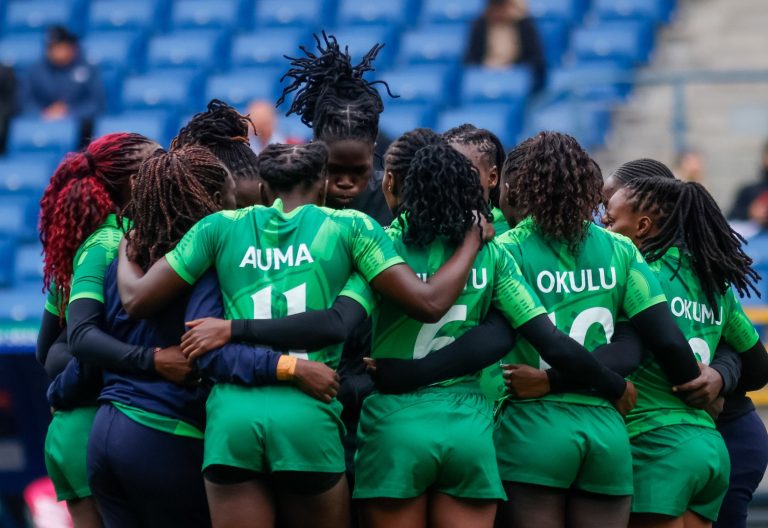Art economy: Kenya’s art scene is on the upward trend

For a long time, there have been lingering doubts on the viability of the local art market. Truth is, the visual art scene in the country and the whole continent is spectacular and there is an endless upsurge of talent.
And yet, with all this creative inundation, Africa only makes a paltry 0.01 per cent of the global art sales. Seeing what this creative vibrancy can do for the art business, local stakeholders in the industry are establishing institutions to will help bolster art’s sustainability.
From the age of five, Katanu Kay has been an avid art creator, but until this year, she hadn’t thought of taking it up as a long-term career path. Her maiden art exhibition that unveiled her genius strokes to the world was a pop-up art show in 2016 at the dusitD2 in Nairobi.
At 17, she was selling painting after painting. Her creative trajectory has led her to Savannah College of Art and Design in Georgia, where she is a painting major.
“My vision was to make sure I involved myself anywhere in the creative industry. It has now narrowed down to painting. My brand is still something that I am developing and refining. I wouldn’t say it’s concrete at the moment. When it comes to packaging my art, I simply create what I think looks good and hope that people like it as well,” says Katanu.
Many of her paintings are embellished with the kitenge fabric, a technique she has mastered as well as abstract brush strokes in the background. Other paintings are what she terms ‘a little more realistic’.
Conducive institutions
“Quite frankly, I am still slowly exploring the art scene. What I can deduce from my experiences is that the art space in Kenya is expanding and this warms my heart. I do wonder, however, how the economy will support it because being an artist in Kenya can be difficult and, especially with the current economic status,” she says.
The global art sales in 2018 were US$67.4 billion (Sh6.7 trillion) according to the UBS Art Basel report. Africa and South America made up less than four per cent of the global sales. While some Kenyan artists such as Wangechi Mutu have made it to the market in Europe and USA, the domestic market is still in its nascent stages.
Wabunii Sacco CEO Roy Gitahi says the Kenyan art market is going places now that there’s a conducive environment for institutions of art to thrive. The Sacco highlights the missing link between creatives and banks, with banks classifying the visual art industry a high-risk borrower.
The institution, therefore, set up an initiative dubbed Art at Work, which lobbies for the inclusion of art in the mainstream financial sector as an asset class.
Here, artists can save and borrow funds to improve their talent and product offering. Kenya passed the Movable Property Security Rights Act of 2017, which allows the use of intangibles such as art as security for loans.
At Wabunii Sacco, art and music can act as collateral for loans. Art at Work has coupled up with Kikao Law to provide creatives with education, resources and representation in matters relating to Intellectual Property.
Millennials takeover
“Africa is still playing catch-up, but we are moving forward nonetheless. In March, 2019, we had the Art and Finance Conference where we concluded that as a country, we will work towards gaining a five per cent market share in the continent in the next 10 years.
If we remain on track, Kenya will be one of the first African countries in the world to trade art on Nairobi Securities Exchange,” says Gitahi.
Now, this is absolutely possible if all stakeholders understand their role in this ecosystem in order to create a sustainable value chain. And this starts with the artists who must have sufficient literacy on the rules of the game. Creating art and putting it up for sale is not enough.
Artists who intend to capitalise their art must understand the market value of their work and how the law protects their Intellectual Property.
Gallerists, curators, collectors, art dealers, art critics, auctioneers and museums are all stakeholders. Gallerists understand the market because they are always exposed to it.
A collector is more like a primary buyer who promotes the artists, invests in a secondary market and accelerates art value. Collectors have always been perceived as wealthy individuals with affluent lifestyles, but this theory no longer holds because millenials are making up a big part of the market.
According to the UBS Art Basel Report 2018, millennials accounted for just under half (45 per cent) of high-end spenders, underlining the importance of this demographic. Wielding such economic power means the future of the art economy will be driven by this group, which is ready to spend.
“This is a generation that is looking for stories and narratives behind art and they are willing to buy as long as it resonates with them. In fact, young people should buy art from their peers because it appreciates in value over years. One might end up holding the only copy of a historical moment that everybody wants to have,” he tells Spice.
“The general perception is that visual art is a preserve of a few and that it is costly. But this is definitely not the case. Local art is authentic, highly aesthetic and can suit different pocket sizes. The availability of different art styles, appeal to different tastes and one can start small and build on their art collection,” says Yrimu Collection founder Wairimu Mwangi.
The Yrimu Collection promotes art and the different styles that appeal to different tastes while making it accessible to the local art audiences. People tend to shy away from investing in the local art scene, but Wairimu sees it as one of the most dynamic sectors of the global economy with a powerful transformative force for socio-economic development.
“For us, the journey in that direction has just began. We are beginning to reconnect with our heritage like never before. We are moving towards redefining our spaces to reflect our identity and heritage. Therefore, there is immense potential locally to drive the visual art industry,” she says.
The gallerist, art dealer and educator identifies with art for its aesthetics and as a form of expression in immersing herself in and unraveling the world around her.
She recognises art as an integral piece of the story of Africa, which is threatened by limitations on opportunities to explore and experience it. The Yrimu Collection steps into this gap to promote artistic expressions in spaces to augment an artistic culture and develop a robust art market.
Corporate effect
“We run pop-up art exhibitions and art education or consultation to bring visual art closer to the art audiences, create deeper appreciation and engagement and the uptake of visual art in our homes and in commercial spaces,” says Wairimu.
The corporate industry has always been faulted for its reluctance in investing in the creative scene, but there are companies setting a great precedence in taking up of local visual art in their spaces. Besides buying art pieces, some of them are becoming pop-up art hubs and promoting artists on various platforms.
Safaricom PLC, dusitD2, The Junction Mall, Rosslyn Riviera Mall, East Africa Breweries Limited, Toyota Kenya and Google are some of the few opening market doors for local art.
Apart from galleries, other spaces such as nightclubs, party spaces, event venues, concerts and festivals are becoming art exhibition scenes. Artists are also opening their own studios and using the power of social media to beckon audiences.
There is an upsurge in the number of galleries set up around Nairobi and this indicates that an interest in local art is growing. This is in spite of the low investment in art education within our education system. Top art galleries such as Banana Hill Art Gallery, The GoDown Arts Centre, Shifteye Studios, Circle Art Agency, Red Hill Art Gallery, and The Art Space Gallery (now an online space) are constantly hosting art shows and pop-ups.
While local art is being made by Kenyans, art collection, dealing and curating has been visibly dominated by foreigners for a long time. These people come from countries that are traditionally art markets and they have an appreciation for art that we don’t. But local gallerists and dealers are reclaiming their place curating ‘our’ stories.
“The visual art industry has largely been driven by foreign markets. While these efforts are laudable and necessary, there is great potential from the local industry to drive the uptake of local visual arts. Our focus is to drive the local appreciation of art and grow the local primary and secondary market. Our commercial and home environments are dominated by stock images that are industrially manufactured elsewhere. Ours is to reverse these trends by making local visual art that is authentic and aesthetic to be accessible by the local market,” says Wairimu.
Artist rights
The Copyright Amendment Bill 2017 looks out for artists. In this bill, an artist has a right to five per cent of the fees once an art piece is resold on the secondary market. But because art travels, it is difficult to track resales. The more it travels, the more value it accumulates and often the artist ends up losing on income because of the inability to track the chain of custody.
Auctioning art fairs and online sales are other growing trends in the local art market. The global art auction figures rose by three per cent in 2019 reaching USD$29.1 billion (Sh2.9 trillion). In Kenya, The Modern and Contemporary Art Auction East Africa 2019 was held in March at Radisson Blu Hotel, Nairobi. The total auction sales exceeded Sh30 million, with 90 per cent of the 59 lots sold.
Some of the artworks that scored high bids were by Kenya’s Ancient Soi, Camille Wekesa, late Ugandan Geoffrey Mukasa, South Africa’s Charles Sekano, Tanzania’s Edward Saidi Tingatinga and Nigeria’s Jimoh Buraimoh.
Insurance companies are reluctant to accept art as an asset. They consider art as goods in transit as it constantly travels. However, some of these insurers have a grand appetite for impeccable art and are welcoming it.
Says Wairimu, “Our visual art infrastructure that is required to drive the art industry is largely underdeveloped. We lack the different components that it takes to drive the industry in various towns. As The Yrimu Collection, we play the combined role of art gallerists, curators, art dealers, art collectors and art educators to democratise the uptake of visual art.”








